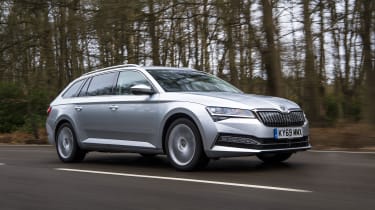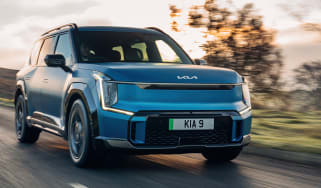Skoda Superb Estate hybrid review
Roomy, sweet to drive, good value by plug-in standards and efficient even with little charge, the Skoda Superb Estate is one of the best PHEVs there is
Pros
- Affordable compared to other PHEVs
- Efficient under petrol or electric power
- Practical and classy-feeling
Cons
- Expensive vs non-electric Superbs
- Finance deals could be better
- Many driver aids are optional
| Car type | Electric range | Fuel economy | CO2 emissions |
|---|---|---|---|
| Plug-in hybrid | 32-35 miles | 149-217mpg | 32-42g/km |
The Skoda Superb iV Estate is one of the best plug-in hybrid cars in any class. Its chief rivals include the Volkswagen Passat GTE – with which it shares a lot of technology – as well as models like the Mitsubishi Outlander PHEV SUV, BMW 330e Touring and Peugeot 508 SW Hybrid.
If you want loads of room, great efficiency, a comfortable ride and a smooth, quiet driving experience, you can’t go wrong with the big plug-in Skoda. Official electric range from the 13kWh battery is up to 37 miles for the Superb iV hatchback. The cheapest estate, the SE L, will do some 35 miles, while racier SportLline Plus drops that range to 32 miles.
We drove the SE L on 18-inch alloys, and saw an electric range of nearly 30 miles on a drizzly, 10-degree winter's day. In even colder weather, that’ll drop to more like 25 miles. A full charge takes four hours from a dedicated Type 2 charger or home wallbox, while plugging into a three-pin socket ups that to six hours.
More than that, the Superb’s 1.4-litre turbocharged petrol engine and six-speed dual-clutch automatic gearbox prove impressively efficient, with real-world economy of around 45mpg over a mix of motorway, town and country roads. That's better than you’ll get from just about any other plug-in hybrid. It’s a quiet car, too, the Superb. That petrol engine is very smooth, and in pure electric mode there’s even less noise. There's a bit of suspension thump, but there’s no doubting that the Superb Estate is a seriously refined car.
It’s also comfortable; adaptive dampers are fitted as standard, which is odd since they’re an expensive option on the pricier Passat GTE. Still, this is to the Skoda’s benefit, as they help it to soak up all but the worst pothole or surface intrusion, although in softer settings there's a lot of body movement and you’re always aware of how big and heavy the car is. Sport mode tightens up that body lean and makes the front-wheel-drive Superb feel even more secure and neat through corners, but it’s never a car that you feel like driving vigorously, despite its 215bhp and 0-62mph time of 7.8 seconds.
Practicality is great, with a 510-litre boot offering masses of space and underfloor storage for the standard Type 2 and three-pin cables. There’s also limousine-like rear legroom, so even tall adults will be happy in the back seats. Equipment is very good, too. We recommend the SE L, which gets keyless entry and go, full matrix LED headlights, 18-inch wheels, leather upholstery with heated front seats, a power-adjustable driver’s seat, a powered bootlid and an eight-inch touchscreen sat nav and media system.
That colour screen is the focal point of the logical if rather ordinary-looking dashboard, and gets Bluetooth, voice control, digital radio, multiple USB ports, Android Auto and even wireless Apple CarPlay. It’s not always the fastest-responding screen, but it’s got all the features you want, has crisp graphics and is easy to navigate. On SE L, you have to pay four figures to upgrade to a 9.5-inch touchscreen, but the higher two trims get this bigger screen as standard. The digital ‘virtual cockpit’ will be another popular option on the SE L, as it brings a configurable driver’s readout.

SportLine Plus gets bigger wheels, the virtual cockpit, Alcantara sports seats and more, while Laurin & Klement gets luxuries like a panoramic sunroof and massage function for the driver, but it does creep over £40,000, resulting in higher annual road tax, which is why we’d avoid it. Oddly, you have to pay extra for a reversing camera, traffic-sign recognition and lane-keeping assistance on all but the top-spec L&K, although blind-spot monitoring is included, as are autonomous emergency braking, front and rear parking sensors and adaptive cruise control.
Company-car drivers will find the Superb iV Estate very tempting given its low BiK rates. Private buyers looking to pay monthly might find costs a little high, as currently Skoda expects PCPs to come to around £430 a month for the SE L, even with a chunky £6,000 deposit on a three-year deal. Considered next to the much cheaper non-electrified Superb Estates, the iV looks expensive, but with the promise of big fuel savings if you mostly do shorter journeys, and the draw of very low company-car tax costs also in its favour, it’s not hard to see why it’ll still be a really popular option in the Superb range.
Overall, the Superb iV Estate is a fantastically functional, comfortable and likeable plug-in hybrid package. It’s one of our favourite plug-in hybrids of any class, so it’s also good value in context of the big PHEVs it competes with only makes it even better. For a more detailed look at the Skoda Superb iV Estate, read on for the rest of our in-depth review...




